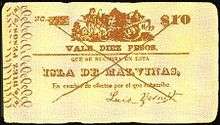Malvinas Islands peso
The peso was a promissory note issued on the Falklands Islands (Spanish: Islas Malvinas) by Luis Vernet from around 1828 until the collapse of his settlement in August 1833. Vernet, who was appointed Governor by the United Provinces of the River Plate in 1829, paid workers on the islands in these promissory notes.[1]

.jpg)
Following the Lexington raid in 1831, the settlement was in some disarray. When Vernet's deputy, Matthew Brisbane, returned in March 1833, he devalued these promissory notes as a reflection of Vernet's reduced status. This combined with the attempted re-assertion of authority after months of anarchy following the Lexington raid led a gang of Creole and Indian gauchos to run amok in the settlement killing the five senior members of Vernet's settlement, including Brisbane.[1]
So many of these notes were issued that they continued in use as a currency long after the British return in 1833. So much was still circulating 10 years later, even in the Government treasury, that Governor Moody issued hand written notes in exchange.[2]
Banknotes
Paper money was issued in denominations of 1, 2, 5 and 10 pesos. The notes were uniface and printed in black ink.
References
- Pick, Albert (1990). Standard Catalog of World Paper Money: Specialized Issues. Colin R. Bruce II and Neil Shafer (editors) (6th ed.). Krause Publications. ISBN 0-87341-149-8.
- A brief history of the Falkland Islands Part 3 - Louis Vernet: The Great Entrepreneur Archived 2010-04-01 at the Wayback Machine, Accessed 2007-07-19
- Falkland Islands Journal, 1974